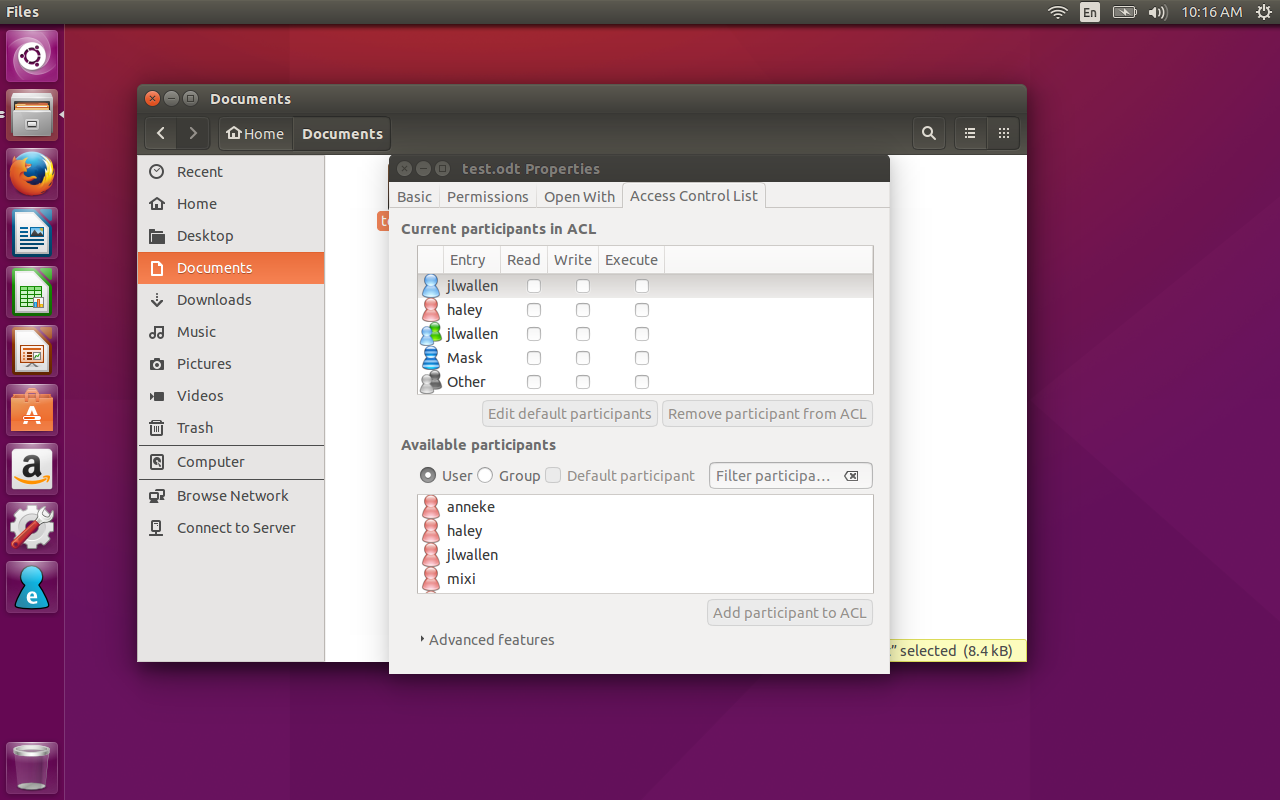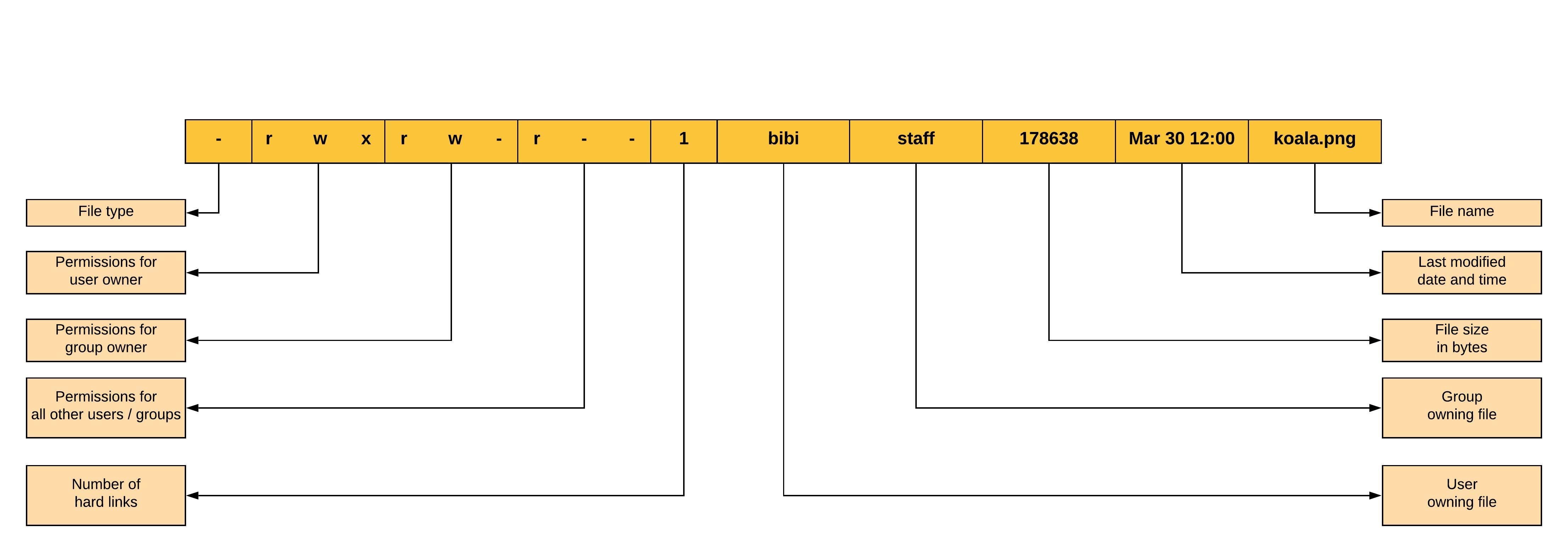To change the permissions of a file, one uses the chmod command, with the following syntax The references are shorthand ( u , g, or o) for each class The operator determines whether to add ( ), remove ( ) or explicitly set ( =) the particular permissions The modes are read ( r ), write ( w ), or execute ( x )Having looked at the file permissions and how to view them, let's no focus on how to modify these permissions The chmod command in Linux is used to change file and directory permissions using either text (symbolic) or numeric (octal) notation It takes the following syntax $ chmod OPTIONS MODE filename Only the root user or a regularI have tried to SSH into my AWS Ubuntu server and copy the directory to my local machine Throughout the process I experience different file permission errors (noted below) I updated the file permissions to chmod 660 sentimentpem After the update, the permissions were set to

A Windows Guy In A Linux World Users And File Permission
Change permissions file ubuntu chmod
Change permissions file ubuntu chmod-Others can read only" chmod R 755 myfiles Recursively (R) Change the permissions of the directory myfiles, and all folders and files it contains, to mode 755 User can read, write, and execute;Group members and other users can read and execute, but cannot write



Ubuntu Local Network Share Failed To Mount Windows Share Permission Denied Ubuntu Forumming
Chmod Modifies File Permissions In Linux, who can do what to a file or directory is controlled through sets of permissions There are three sets of permissions One set for the owner of the file, another set for the members of the file's group, and a final set for everyone else The permissions control the actions that can be performed on the file or directoryI'm running Ubuntu 04 LTS under WSL and would like to use an existing pem file to connect via ssh to a remote system using Windows Terminal Initially, the access rights for the file weren't correct and therefore it was rejected by ssh (as documented)Chmod Command in Linux (Managing File Permissions) Written by Rahul, Updated on December 19, Linux chmod command is used to change access permissions of files and directories In this article, you will learn how to change permissions of any file or directory with chmod command We have already described the Linux file permissions
The chmod command changes the access permissions of files and folders The chmod command, like other commands, can be executed from the command line or through a script file If you need to list a file's permissions, use the ls command Mykyta Dolmatov / Getty Images Command SyntaxGroup members and other users can read and execute, but cannot writeExamples chmod 644 filehtm Set the permissions of filehtm to "owner can read and write;
Understand how Ubuntu / Linux file permissions and special mode bits work Learn how to change these permissions using the chmod command Find out how default permissions for new files are configured via a user's umask valueChmod is a very helpful command to change the file permissions of a file or a folder in any UNIXlike operating system Let's say you are currently in the root directory of your Unixlike system and you want to change the file permissions of a folder and all of the other files and subdirectories present inside that folderExamples chmod 644 filehtm Set the permissions of filehtm to "owner can read and write;



How To Manage User Permissions From The Gui On Linux Linux Com



Not Allowed Because You Don T Have Permissions To Create Subfolders In That Folder Issue Nextcloud Server Github
In the above command, sourcefile is the file whose permission bits you want to copy, and destinationfile is the file whose permission bits you want to change Moving on further, there's also a numerical notation (also known as octal representation) using which you can tell chmod to change permissionsChmod 755 /path/to/file chmod 700 Everything for owner only This command will give read, write and execute permission to the owner Group and others will have no permissions, not even read chmod 700 /path/to/file chmod 666 No one executes To give owner, group and everyone else read and write permission on file chmod c 666 /path/to/fileChmod file does not have metadata (default) Chmod will only have one effect, if you remove all the write attributes of a file then the 'read only' attribute on the Windows file will be set, since this is the same behaviour as CIFS (Common Internet File System) which is the SMB (Server Message Block) client in Linux chmod file has metadata



Basic Linux Commands Ubuntu



Ubuntu Users How Do You Even Launch Qgc Using Qgroundcontrol Discussion Forum For Px4 Pixhawk Qgroundcontrol Mavsdk Mavlink
Set permissions on files & directories using chmod in Ubuntu First, we will discuss user related permissions – this will make modifications to first three characters aforementioned To add permissions for a user, we can use following combinations – chmod ur ABCtxt chmod uw ABCtxt chmod ux ABCtxt where,Image link chmod permission for user I am trying to understand different permission for text file in linux , please refer the image i have attached i want to ask two question 1 when the text fileOthers can read only" chmod R 755 myfiles Recursively (R) Change the permissions of the directory myfiles, and all folders and files it contains, to mode 755 User can read, write, and execute;



File Permissions In Linux Geekstarts



Education Background Png Download 744 1052 Free Transparent Ubuntu Png Download Cleanpng Kisspng
In Ubuntu I want to change the file permissions of a whole folder and all its sub folders to read/write by anybody I have tried sudo chmod 666 /var/www and sudo chmod 755 /var/www without success update I have since found that changing privileges can also be done in the GUI by opening nautilus as sudoIn the above command, sourcefile is the file whose permission bits you want to copy, and destinationfile is the file whose permission bits you want to change Moving on further, there's also a numerical notation (also known as octal representation) using which you can tell chmod to change permissionsChanging multiple files/directories permission recursively using chmod recursive (R) Changing permissions of only files Changing permissions of only directories And many more In this tutorial, we are going to see how to use the chmod command and how we can change files/directories permission recursively using chmod recursive (R)



Directory How Can I Change Permissions Of A Folder Including Its Enclosed Files And Subdirectories Ask Ubuntu



Linux Commands Cheat Sheet Definitive List With Examples
I have tried to SSH into my AWS Ubuntu server and copy the directory to my local machine Throughout the process I experience different file permission errors (noted below) I updated the file permissions to chmod 660 sentimentpem After the update, the permissions were set toUnderstand how Ubuntu / Linux file permissions and special mode bits work Learn how to change these permissions using the chmod command Find out how default permissions for new files are configured via a user's umask valueAs explained in the article Permissions in Linux, Linux uses a combination of bits to store the permissions of a fileWe can change the permissions using the chmod command, which essentially changes the 'r', 'w' and 'x' characters associated with the file Further, the ownership of files also depends on the uid (user ID) and the gid (group ID) of the creator, as discussed in this



How To Change The Permission Of File In Ubuntu Youtube



Linux File Permissions And Ownership By Udara Bibile Level Up Coding


